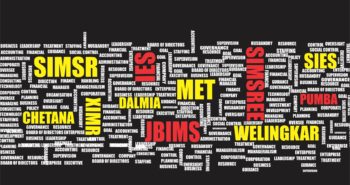MBA/MMS CET is an entrance exam conducted by DTE-Maharashtra for admission into MBA colleges in Maharashtra with curriculum governed by universities in Maharashtra. The exam is generally conducted in March. As an exam it assesses applicants on various important parameters like intelligence, time-management, resource management and a bit of luck. The general pattern of the exam is 200 MCQ questions having 5 options each to be solved in a total of 150 minutes.
So, on the face of it, it appears to be 150/200 = 0.75 mins (=45 seconds) per question i.e. it is within these 45 seconds that you need to read, understand, solve and mark answer to a question.
That’s quite scary to many and almost impossible for a few. Nevertheless, here are a few aspects of the exam that might make it less scary to say the least.
- You need not score 200. You just need to score better than others.
Historically, NOBODY has ever scored 200 in the CET exam. Applicants take the CET to secure admission in good institutes like
– Jamnalal Bajaj Institute of Management Studies (JBIMS),
– Sydenham Institute of Management Studies, Research and Entrepreneurship Education (SIMSREE),
– K. J. Somaiya Institute of Management Studies and Research (SIMSR), (*SIMSR wont be taking admissions through CET from 2020 as the institute has converted all MMS seats to MBA and will not be governed by Mumbai university anymore.)
– Welingkar Institute,
– Department of Management Sciences, Pune University (PUMBA),
– South Indian Education Society’s College of Management Studies (SIESCOMS),
– N.L. Dalmia Institute of Management studies and Research,
– Xaviers Institute of Management and Research (XIMR),
– Indian Education Society Management College and Research Centre (IES MCRC),
– Maharashtra Education Trust Institute of Management (MET IOM),
– Chetana’s Institute of management and Research (CIMR)
and others.
Admissions to these colleges for the MBA/MMS courses are through the Centralised Admission Process (CAP). There are admission reservations available for candidates belonging to different universities and castes. Hence, the college admission cut-off for different types of candidates varies. Generally, the cut-off is highest for a candidate who is not from Maharashtra. However in 2018, the cut-off was highest for General category Maharashtra candidate in JBIMS as there were no seats for Non-Maharashtra candidates there. To secure admission in JBIMS, a Maharashtra general category candidate needs to be in the top 50 ranks amongst approximately 1 lakh aspirants. In 2019, the cutoff was 145 (rank 52). In 2018, the cut-off was 140 (rank 54) while in 2017, it was 125 (rank 52).
- There are no negative marks in the exam
Going by the concept of probability, even if you randomly mark an answer to a question in CET, the probability for getting the answer correct is 1/5. Hence for 200 questions, the score should be around 40. In a way, CET gives everyone a head start of 40 marks in the exam. Given that there are no negative marks, candidates can take risks in answering questions – especially the ones where one can eliminate a few options thereby increasing the probability of getting the answer right. Also, candidates may choose to randomly mark answers to questions that they find difficult or time consuming thereby saving some additional time to solve the easy questions.
In a way, CET gives everyone a head start of 40 marks in the exam. Given that there are no negative marks, candidates can take risks in answering questions – especially the ones where one can eliminate a few options thereby increasing the probability of getting the answer right. Also, candidates may choose to randomly mark answers to questions that they find difficult or time consuming thereby saving some additional time to solve the easy questions.
Invariably, every student must attempt all the questions. Some students reserve the last 10 minutes to randomly mark answers to un-attempted questions. Some students mark answers to all questions on the go. They choose the mark for review option on the go and come back to such questions in their second scan. There are also a few candidates who mark random answers to all the questions in the first 5 minutes and then come back to solve questions and change the option if needed. This is not a bad strategy as you also get to scan all the questions in the first 5 minutes. Although, you need to keep a track of which questions have been solved and which ones have not.
- All questions carry equal marks and you are allowed to navigate throughout the exam
The biggest difference between a student who is well prepared for CET and one who is not is the order of solving the questions. Given the premise that it is next to impossible to genuinely solve all 200 questions, the argument is which questions to solve and which not to.
So, if nobody can genuinely solve all questions, how does the order of solving the questions matter? If you solve questions sequentially, there’s a good chance, you won’t reach till the end. For all you know, a lot of easy questions may be among the last ones. ‘The time taken to solve an easy question is generally way less than the time taken to solve a difficult one. So, the time taken to solve 1 difficult question can be used to solve 2-3 easy questions instead and thereby score better as all questions carry equal marks. Also, difficult questions act as speed-breakers as they cause mental fatigue. So, many a times even if the next question is easy, candidates tend to take more time solving it.
Now, how to decide the order of attempting the questions? For this, a thorough knowledge of questions is necessary.
Here’s a list of different topics on which questions are generally asked in CET.
- Quantitative Ability and Data Interpretation section (50 Questions):

i. Problem Solving (10-17 questions)
Arithmetic (6-9 questions) – Ratio, Work, Speed Time Distance, Simple Interest Compound Interest, Profit Loss.
Algebra (1-4 questions) – Properties of Numbers, Prime factors, HCF, LCM, Divisibility rules, Equations
Geometry (1-3 questions) – Properties of Triangles, Quadrilaterals and Circles, Mensuration (Perimeter, Area and Volume of 2D and 3D figures)
Modern Maths (1-2 questions) – Permutations, Combinations and Probability
ii. Quantitative Comparison (6 questions)
iii. Data Sufficiency (4-5 questions)
iv. Number Series (0-6 questions) – Odd man out, finding next term / missing term
v. Data Interpretation (4 sets having 23 – 25 questions)
Caselet (Set of 5-7 questions)
Tabulated data (Set of 5-6 questions)
Line Graph (Set of 5-6 questions)
Pie Chart (Set of 5-7 questions)
- Verbal Ability and Reading Comprehension section (50 questions)
i. Reading Comprehension (2-3 passages having 4-8 questions each)
ii. Parajumbles (5 questions)
iii. Parajumbles odd man out (0-5 questions) – Inappropriate sentence in context, sentence not contributing to the main idea of the passage
iv. Para completion (0-5 questions) – missing part of paragraph
v. Vocabulary and/or Grammar related questions (20-35 questions)
Cloze Passage (1-2 passages having 5-8 questions each)
Incorrect usage or spelling in a given sentence (0-5 questions)
Correctly used phrase (0-3 questions)
Fill in the blanks (0-3 questions) – Independent sentences with 1/2/3 blanks
One word three blanks (0-7 questions)
Synonym/Antonym (0-5 questions)
Match the columns (0-5 questions)
Choose grammatically incorrect fragment in a sentence (0-7 questions)
Choose grammatically correct sentences (0-5 questions)
Identify sentences with the same meaning (0-2 questions)
Join the given sentences / sentence starters (0-5 questions)
Set of sentences with four words marked in bold (0-6 questions)
Match the column (0-3 questions)
- Logical Reasoning section (75 questions)
i. Arrangements (22-36 questions)
Matrix/Tabular Arrangement (2-3 sets of 5-7 questions each)
Linear Arrangement (1-2 sets of 5 questions each and 0-2 independent questions)
Rectangular/Square Arrangement (0-1 set of 2-3 questions)
Circular arrangement (special type of set having few members facing inwards and others facing outwards and combined with family relations. 1 set of 6-8 questions)
Scheduling (0-1 set of 3-5 questions)
ii. Family/Blood Relations (3-5 questions)
iii. Sequential output (0-1 set of 5-6 questions)
iv. Logical Data Sufficiency (0-5 questions)
v. Coding – Decoding (0-7 questions)
vi. Word / Number Series (0-6 questions) – complete the series or identify the wrong element in the series
vii. Directions (0-3 questions)
ix. Symbol based comparison (4-7 questions)
x. Odd man out (0-5 questions)
xi. Syllogisms / Deductions (5-7 questions having 4/5 variables)
xii. Verbal Reasoning (10-11 questions)
Cause and Effect (1-2 questions)
Identify Strong / Weak Arguments (1-3 questions)
Assertion and Reason (0-1 question)
Critical Reasoning (6-8 questions) – Single paragraph independent question on Conclusion / Inference / strengthen or Weaken arguments / Assumptions / Summary
xiii. Decision making / course of action (set of 0-5 questions) – haven’t been asked in CET for the last 5 years.
- Visual/Abstract Reasoning section (25 questions)
i. Series based questions (15 – 20 questions) – First / middle / last figure missing in a series of 4-6 figures
ii. Analogies (5-10 questions) – finding similar/dissimilar figure/pair
Once you are thoroughly familiar with all the types of questions, you should categories the questions as High speed questions (average solving time less than 45 seconds per question) and Low Speed questions (average  solving time more than 45 seconds per question). For some questions, this classification is obvious. For example, Grammar and Vocabulary are high speed questions while Caselets and Visual Reasoning are low speed questions. For a person who is good with maths (especially who can comfortably work with options), most of the Problem Solving question will be high speed questions whereas for a regular reader, questions on Verbal ability and verbal reasoning will be high speed questions. Ideally, you should have at least 80 questions in high speed category. If not, then change the definition of high speed questions that suits at least 80 questions accordingly (say less than 60 seconds per question. However, you then need to work hard to bring this to 45 seconds per question).
solving time more than 45 seconds per question). For some questions, this classification is obvious. For example, Grammar and Vocabulary are high speed questions while Caselets and Visual Reasoning are low speed questions. For a person who is good with maths (especially who can comfortably work with options), most of the Problem Solving question will be high speed questions whereas for a regular reader, questions on Verbal ability and verbal reasoning will be high speed questions. Ideally, you should have at least 80 questions in high speed category. If not, then change the definition of high speed questions that suits at least 80 questions accordingly (say less than 60 seconds per question. However, you then need to work hard to bring this to 45 seconds per question).
In the first scan solve the high speed questions. The idea here is to start scoring marks immediately while scanning the exam. Once you have scanned through all the questions and attempted all the high speed questions, come back and solve the low speed questions. Now, given that you may not be able to solve all the questions, you need to select what to solve and what to skip (in case of CET, skip would mean randomly mark any answer option). So the parameter now is to categorise the low speed questions into high accuracy (general accuracy more than 70%) and low accuracy questions (general accuracy less than 70%). This classification is possible only if you have taken plenty of practice tests (Mock-CETs) and analysed thoroughly. Accordingly, attempt all the High accuracy questions and then, if time permits, solve the low accuracy questions.You should try this technique in a few Mock-CETs to improve your selection of questions. Eventually, you’ll be able to prioritise the order of questions based on a more refined parameter – “time spent per mark earned” which is a combination of speed and accuracy. While attempting MockCETs, experiment with the order of questions and sections and see what works the best for you. In this process, you’ll also be able to identify the questions that are speed-breakers or potential traps. Also, you will be able to estimate the time required to attempt a question based on level of familiarity, length of the question, complexity of language, nature of questions, number of questions in a set, possibility of working with options, comfortable values, number of calculations needed and scope of approximations. Also, you’ll be able to identify a few trade-offs if you come to know that spending more time on a particular type of question improves your accuracy. Although, it’s only worth making this trade-off if the average time spent per mark earned improves with it. You can try this out with Visual Reasoning questions to get a first-hand experience.
- The exam rewards smart and sincere candidates over intelligent candidates

Unlike other management exams like the CAT, XAT and the CMAT those favour accuracy; the CET is more about speed. The CAT and XAT have difficult questions and average time per question is relatively higher than the ones in CET. In other words, the CAT and XAT are exams that handsomely reward intelligence as only the intelligent few can solve the difficult questions there. CET, on the other hand, has easy questions that most of the people can solve. Hence, the major discriminator in CET is speed that comes through smart work and sincerity. Smart work would mean better time management and a better order of attempting questions during the exam as discussed in the above points. Nevertheless, just smart work isn’t enough to be in the top rankers. You also need good speed and accuracy to maximise your score. Speed and accuracy come through practice. When you solve plenty of questions of a particular type, the solving process for that kind of question becomes mechanical in nature thereby saving time and energy on solving that type of question on D-day. The best way to practice is Mock-CETs. Most of the toppers in CET are people who have solved 15+ Mock-CETs. Don’t get discouraged if your scores have been low in the initial few Mock-CETs.
Mock-CETs should be considered as a learning tool rather than a testing tool. While taking Mock-CETs, don’t hesitate from taking a few chances. Try to solve questions by eliminating options as much as possible. Each wrong option that you eliminate increases the probability of getting the answer right. Mark a few answers based on hunch and see how it has worked for you during analysis. Try to speed-read and speed-calculate. Make sure you attempt all 200 questions every time. If you get an answer right, you gain confidence; and if you get it wrong, you gain learning. Learning from one’s mistake is long-lasting in nature thereby increasing the accuracy in future. During analysis, try to make a note of all different types of errors that you have committed in the test and learn from it. All you need to do is ensure that you don’t repeat the same type of mistakes in the future. Also, don’t care too much about your percentile in a MockCET for 2 reasons: 1. You are experimenting and 2. You are competing only with yourself. Ask yourself what you could’ve done better and what could’ve been your potential score had you not committed silly errors. This will be a continuous learning process that leads to excellence.
A word to the wise: During the exam, it wouldn’t matter if the questions are difficult or easy or lengthy or deceptive. It wouldn’t matter how many questions you solve and how many others did. All that would matter is your answer to a simple question: “Is this the best I could’ve done?”
– RUSHABHSEN SANGHANI
H R MENTORS
99.98%ile – CET 2015



 In a way, CET gives everyone a head start of 40 marks in the exam. Given that there are no negative marks, candidates can take risks in answering questions – especially the ones where one can eliminate a few options thereby increasing the probability of getting the answer right. Also, candidates may choose to randomly mark answers to questions that they find difficult or time consuming thereby saving some additional time to solve the easy questions.
In a way, CET gives everyone a head start of 40 marks in the exam. Given that there are no negative marks, candidates can take risks in answering questions – especially the ones where one can eliminate a few options thereby increasing the probability of getting the answer right. Also, candidates may choose to randomly mark answers to questions that they find difficult or time consuming thereby saving some additional time to solve the easy questions.
 solving time more than 45 seconds per question). For some questions, this classification is obvious. For example, Grammar and Vocabulary are high speed questions while Caselets and Visual Reasoning are low speed questions. For a person who is good with maths (especially who can comfortably work with options), most of the Problem Solving question will be high speed questions whereas for a regular reader, questions on Verbal ability and verbal reasoning will be high speed questions. Ideally, you should have at least 80 questions in high speed category. If not, then change the definition of high speed questions that suits at least 80 questions accordingly (say less than 60 seconds per question. However, you then need to work hard to bring this to 45 seconds per question).
solving time more than 45 seconds per question). For some questions, this classification is obvious. For example, Grammar and Vocabulary are high speed questions while Caselets and Visual Reasoning are low speed questions. For a person who is good with maths (especially who can comfortably work with options), most of the Problem Solving question will be high speed questions whereas for a regular reader, questions on Verbal ability and verbal reasoning will be high speed questions. Ideally, you should have at least 80 questions in high speed category. If not, then change the definition of high speed questions that suits at least 80 questions accordingly (say less than 60 seconds per question. However, you then need to work hard to bring this to 45 seconds per question).



